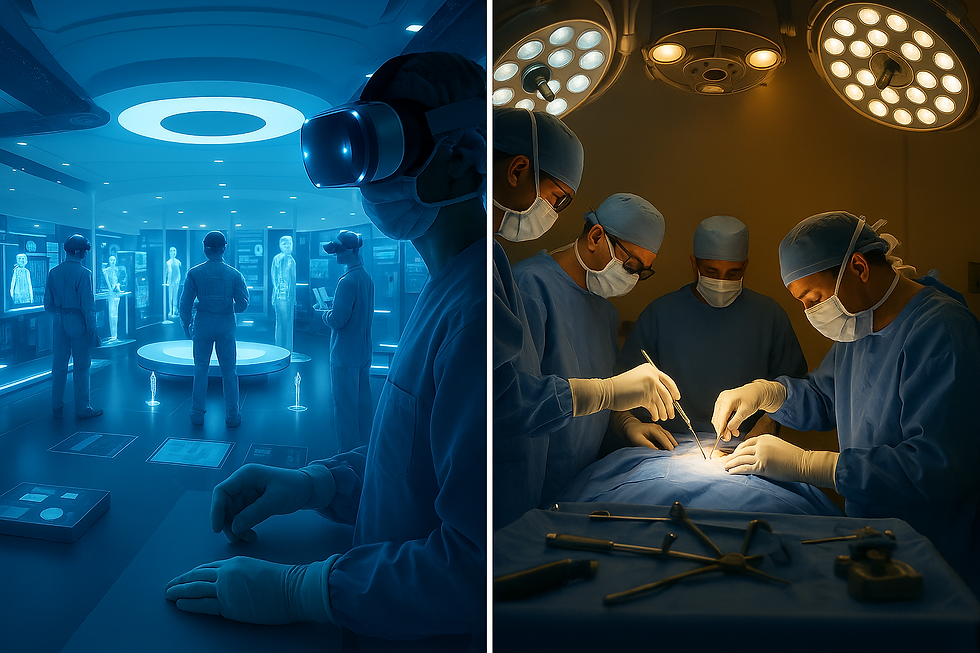How VR is Transforming Surgical Skill Labs
- vincentdsouza
- Jul 16
- 3 min read

For centuries, cadaver-based dissection has been the cornerstone of surgical education. It offered future surgeons a first glimpse into human anatomy and a rare chance to explore the body before ever entering the operating room. But as technology evolves, so too must the methods we use to train the next generation of surgeons.
Today, Virtual Reality (VR) is redefining what’s possible in surgical skill labs — offering an immersive, repeatable, and scalable alternative that may signal the end of cadavers as the gold standard in medical training.
Why Cadavers Fall Short in Modern Medical Education
While cadaveric dissection has undeniable value, it presents multiple challenges:
Limited Availability: Many medical colleges struggle to obtain a steady supply of cadavers, especially in rural areas.
High Costs: Preservation, storage, and ethical compliance make cadaver-based labs expensive to maintain.
One-Time Use: Cadavers can’t be reused for repeated practice, making repetition difficult for every student.
Inflexibility: It’s impossible to simulate complex or rare conditions, variations in anatomy, or live responses.
In a modern world demanding more competent surgeons and standardized skill outcomes, these limitations create a growing skills gap.
How VR is Reimagining the Surgical Skill Lab
MadVR’s immersive simulation platform offers a powerful solution:
Realistic Anatomy in 3D: From tissue layers to vascular systems, VR allows students to explore and interact with hyper-realistic anatomical structures.
Repetition Without Limits: Students can practice a procedure 20 times, 50 times, or 100 times — until they master it.
Safe to Fail: In VR, mistakes don’t cost lives. They’re a vital part of learning.
Custom Scenarios: From rare cases to complex trauma simulations, educators can expose students to a broader range of conditions than cadavers could ever provide.
Immediate Feedback: Integrated AI offers real-time scoring, tracking errors, timing, and precision helping both students and instructors measure progress.
Is VR Enough? Where It Stands Today
While VR is unlikely to completely replace cadavers overnight, it is fast becoming a core component of blended medical education:
Leading institutions are pairing cadaveric sessions with VR modules to increase exposure.
Skill labs are being equipped with VR suites to enable practice between live dissections.
Surgeons in training are using VR to prepare for procedures before operating on patients.
In fact, VR-based simulations have been shown to reduce surgical errors by up to 40% when used as a pre-operative training tool.
The Global Push Towards VR Surgical Training
Countries like India, where many PG students perform fewer than 10 supervised surgeries per semester, are adopting VR rapidly. Institutions are using MadVR simulators to:
Meet NMC skill lab standards
Expand training access in underserved regions
Reduce dependence on scarce cadaver resources
In regions across Africa, Southeast Asia, and Eastern Europe, VR offers a sustainable way to train surgeons even where cadavers are nearly impossible to source.
Conclusion: The Future is Virtual, but Rooted in Reality
Cadavers will always have a place in surgical history and perhaps in surgical training too, but they are no longer the only path. As VR matures, it’s becoming not just an alternative but a strategic necessity for institutions looking to train more surgeons, more effectively, and more ethically.
In the years to come, the most successful surgical training programs won’t ask "VR or cadaver?"They’ll ask "How can we combine both for the best outcomes?"

Comments